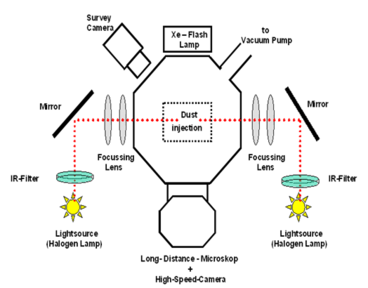photophoretic motion of microparticles (Photophoresis)

research area: astrophysics
experiment title:
Interactions in Cosmic and Atmospheric Particle Systems (ICAPS) - Photophoresis
experiment acronym: Photophoresis
funding agency: ESA
grant number: AO-98/99-018
performing organization:
Institut für Geophysik und extraterrestrische Physik, TU Braunschweig
prime investigator: Prof. Dr. Jürgen Blum
experiment objective
abstract
To understand the formation of planets in the early solar system long-duration experiments with clouds of micrometer-sized particles are planned for the ICAPS facility on board the International Space Station ISS, for example light-scattering and agglomeration experiments. For the implementation of these experiments it is necessary to find a way to manipulate microparticles under microgravity conditions, e.g. to create different velocities between them or to "trap" them within a certain volume, counteracting thermal diffusion and unavoidable external accelerations which would otherwise lead to a dispersion of the particle cloud. We are planning to use the photophoretic effect to realize this kind of trapping and particle manipulation. Photophoresis is the light-induced motion of particles in gases which is due to a temperature gradient across the particles resulting from differential absorption of light. Using strongly absorbing particles, only the illuminated hemispheres are heated and are therefore slightly warmer than the backsides. Molecules of the surrounding gas stochastically hit the particles´ surface which leads to the Brownian motion. Thereby a fraction of the molecules resides on the particles´ surfaces for some time. During this residence time the molecules on the illuminated hemispheres acquire a slightly higher temperature and leave the particles with increased velocities. This leads to a higher momentum transfer and finally to the motion of the irradiated particle away from the light source. This effect is called positive photophoresis. Negative photophoresis, i.e. motion towards the light source, is also possible: Transparent particles focus the incident light such that a somewhat warmer backside results.
related publications
- J. Steinbach, J. Blum, M. Krause, Development of an Optical Trap for Microparticle Clouds in Dilute Gases, Eur. Phys. J. E 15, 287-291, 2004.
- J. Blum, Dust Agglomeration, Advances in Physics 55, Nos. 7-8, 881-947, 2006.
- J. Blum, S. Bruns, D. Rademacher, A. Voss, B. Willenberg, M. Krause, Measurement of the translational and rotational Brownian motion of individual particles in a rarefied gas in the transition region between ballistic and diffusive motion, Phys. Rev. Lett. 97, 230601, 2006.
- D. Langkowski. J. Teiser, J. Blum, The Physics of Protoplanetesimal Dust Agglomerates II. Low Velocity Collision Properties, Astrophys. J. 675, 764-776, 2008.
- J. Blum, R. Schräpler, T. Poppe, G. Borst, Handling of Particulate Solids on the International Space Station, Granular Matter 10, 323-328, 2008.
- J. Blum, G. Wurm, The Growth Mechanisms of Macroscopic Bodies in Protoplanetary Disks, Annual Review of Astronomy and Astrophysics 46, 21-56, 2008.
- R. Weidling, C. Güttler, J. Blum, F. Brauer, The Physics of Protoplanetesimal Dust Agglomerates. III. Compaction in Multiple Collisions, Astrophys. J. 696, 2036-2043, 2009.
- P. Hofmeister, J. Blum, D. Heißelmann, The flow of granular matter under reduced-gravity conditions, in: Powders & Grains 2009: Proceedings of the 6th International Conference on Micromechanics of Granular Media, Hrsg.: M. Nakagawa & S. Luding, AIP Conference Proceedings Volume 1145, 71-74, 2009.
- D. Heißelmann, J. Blum, K. Wolling, Laboratory studies of ice-particle collisions in Satur′s dense rings, in: Powders & Grains 2009: Proceedings of the 6th International Conference on Micromechanics of Granular Media, Hrsg.: M. Nakagawa & S. Luding, AIP Conference Proceedings Volume 1145, 785-787, 2009.
- D. M. Salter, D. Heißelmann, G. Chaparro, G. van der Wolk, P. Reißaus, E. de Kuyper, P. Tuijn, R.W. Dawson, M. Hutcheon, G. Drinkwater, B. Stoll, K. Gebauer, F. J. Molster, H. Linnartz, G. Borst, H. J. Fraser, J. Blum, A Zero-Gravity Instrument to Study Low Velocity Collisions of Fragile Particles at Low Temperatures, Rev. Sci. Instrum. 80, 074501, 2009.
- Heißelmann, D., Blum, J., Fraser, H. J., Wolling, K., 2009. Microgravity experiments on the collisional behavior of Saturnian ring particles, Icarus 206, 424–430, 2010.
experiment campaigns
experiment year: 2009
number of drops: 15
experiment year: 2009
number of drops: 15
experiment year: 2003
number of drops: 15


 "
"